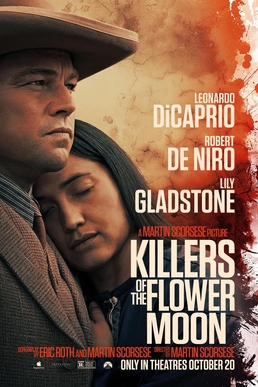A look at Killers of the Flower Moon (PG)

I daresay 90 per cent of us have seen Hollywood movies set in the gun-slinging wild west of the 19th century. But Martin Scorsese’s latest epic western film has fast-forwarded a few decades from those times to the post-World War 1 1920s.
It’s all about oil in the Oklahoma territory, home of the native American Osage nation. Now it’s clear that the Osage weren’t one of the five ‘civilised’ tribes people in this movie talk about – the Cherokee, Chickasaw, Choctaw, Creek or Mauscogee and Seminole nations – who were favourably regarded because they’d bent to the white man’s American culture.
But it’s amazing to see in the early scenes hugely wealthy oil-rich Osage people being chauffeured around in the latest and biggest US limousines.
They’re wearing fur coats with the women sporting exquisite jewellery while most of the white townsfolk in the local towns appear penniless, downtrodden and destitute.
Scorsese has evoked a frenzied, gold rush atmosphere in the town of Fairfax. Yet still in this territory there’s extremely prosperous cattle ranchers such as William King Hale (Robert De Niro) who has his eyes set on the oil-rich lands adjacent to his.
But Hale is going to need assistance in his lengthy plot to expand his fortune so that’s where his dopey nephew Ernest Buckhart (Leonardo diCaprio) fits in.
It’s true Buckhart is a World War 1 veteran, but he didn’t serve as an infantryman in the trenches. He was behind the lines as a cook.
Hale, who’s competent in the Osage native tongue, sets Buckhart up for a marriage into the indigenous clan. He engineers a romance with full-blood Mollie (Lily Gladstone) who has wealth so vast that she’s one of only five people in the USA at that time to be able to acquire insulin for the treatment of diabetes.
King Hale is intent on his nephew eventually marrying Mollie and then murdering her, so he’d be the recipient of a huge inheritance. Mollie had sugar diabetes, but her symptoms don’t surface until well after the marriage and the birth of her three children. But she holds a share of the ‘headrights’ to the oil deposits on her family’s land and so has immense wealth.
And although it’s the 1920s we get only one brief glimpse of the Ku Klux Klan at the town of Fairfax’s fourth of July gala. But nonetheless the mysterious murders of native Americans continue as two of Mollie’s sister’s – one of whom is the town drunk – are found dead along with a civic leading man from the Osage nation.
He’s taken out into the prairie country on a pretence and murdered by a paid hitman, hired by Buckhart.
Hale keeps on telling Ernest that the oil money should “flow the right way” and even though he’s no Einstein the nephew is certain that uncle ‘King’ William knows exactly what should be done.
Then enter the Bureau of Investigations, J Edgar Hoover’s forerunner of the now world famous FBI: the name eventually used by Hoover from 1935 onwards.
Head of the team investigating the Osage deaths is Tom White (Jesse Plemons) who is patient, polite and thorough. He starts with long and arduous questioning of the not-too-bright Ernest who eventually – and perhaps unintentionally – embroils uncle King Hale. In the initial questioning Ernest remains standing during the entire interview. He’s not allowed to sit down so answers in the affirmative to White’s questioning just to able to take a seat – and then later in the cells he’s deprived of sleep.
White also has a few long-ish sessions with King Hale, but he’s not as willing to embroil his family member as was the case in the earlier interviews White and the team carried out.
Unfortunately for the wealthy rancher, Ernest eventually spills the beans and Hale is encircled.
There’s long court scenes where both accused are questioned, eventually leading to the judge’s decision – a decision which we, as the viewers, could probably have second-guessed, anyway.
The film runs for 3 hours and 26 minutes so your ice creams and icy poles will have long been consumed – or melted – by the time the credits flash up. That said there’s quite a bit of lengthy dialogue which could have been cut. Maybe there’ll be a second edition which brings it down to a more manageable time frame.
Nonetheless it’s a great movie and in spite of diCaprio’s constantly drawn and tightly compressed horse-shoe lips I’ve given it four stars, out of five.
